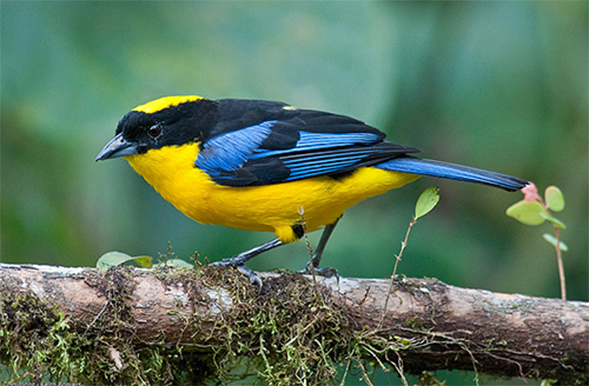Dazzling Colors and Pretty Songs
A songbird study countered the idea of trade-offs limiting evolution.

A study of one of the world’s largest and most colorful bird families has countered a long-held notion that animals are limited in their options to evolve showiness.
The study — the largest of its kind yet attempted — was published this month in the Proceedings of the Royal Society B.
The natural world is full of showstoppers — birds with brilliant colors, exaggerated crests and tails, intricate dance routines or virtuosic singing. But it’s long been thought that these abilities are the result of trade-offs.
For a species to excel in one area, it must give up its edge in another. For example, male Northern Cardinals are a dazzling scarlet but sing a fairly simple whistle, whereas the dull brown House Wren sings one of the most complicated songs in nature.
Best in show
“Animals have limited resources, and they have to spend those in order to develop showy plumage or precision singing that help them attract mates and defend territories,” said Nick Mason, the paper’s lead author. “So it seems to make sense that you can’t have both. But our study took a more detailed look and suggests that actually, some species can.”
Mason did the research as a master’s student at San Diego State University in the laboratory of SDSU biologist Kevin Burns, also an author on the paper. Mason is now a Ph.D. student at the Cornell Lab of Ornithology.
Mason and his colleagues, including fellow former SDSU graduate student Allison Shultz, tested the idea of trade-offs by looking at a very large family of songbirds from Central and South America, the tanagers.
This group consists of 371 species — nearly 10 percent of all songbirds. It includes some of the most spectacularly colorful birds in the world (such as the Paradise Tanager) as well as more drab birds. The group also includes both accomplished and weak songsters alike.
The research team examined museum specimens of 303 tanager species, using a spectrophotometer to measure nine aspects of plumage coloration, such as brilliance and contrast. They took a similar approach to the birds’ songs, analyzing more than 2,700 recordings to measure 20 song variables including length, bandwidth and number of syllables.
By the end of the project, Mason had earned the distinction of being the largest-ever single user of the Cornell Lab’s Macaulay Library sound archives. Finally, the team compared how plumage and song complexity varied at each of the branches along a recently completed evolutionary tree of the tanager family.
“If there were going to be any group of birds at all that would show this trade-off, the tanagers would be a very good candidate, because there’s all this variation in song and plumage complexity,” Mason said, noting that the group’s large size lends confidence to the statistical analysis.
“But when we dive into it and do some rigorous statistics, it turns out that there is no overall trend. Tanagers can be drab and plain-sounding, or colorful and musical, or anything in between.”
Songs and colors
As a byproduct of the analyses, Mason was able to put together top-10 lists of tanagers with the most colorful plumage and the most complex songs. Those lists help illustrate that there doesn’t need to be a trade-off between singing and plumage.
For example, a single genus of mountain-tanagers had members on both lists. The Lacrimose Mountain-Tanager ranked No. 8 among the most complex songs, while the Blue-winged Mountain-Tanager had the fourth most complex plumage of all 303 species examined.
The study puts a significant dent in the idea of evolutionary trade-offs between plumage and song. It’s still possible that trade-offs take place at the level of genus, Mason said, or that they influence species relatively fleetingly as evolutionary pressures appear and disappear. But as a broad effect on an entire family of birds, evolution doesn’t appear to enforce a voice–plumage trade-off.
One possibility is that the resources needed to develop fancy plumage are different from the ones required for complex songs, freeing tanagers to invest in both forms of showiness simultaneously.
The research was funded in part by the National Science Foundation and the National Geographic Society.



